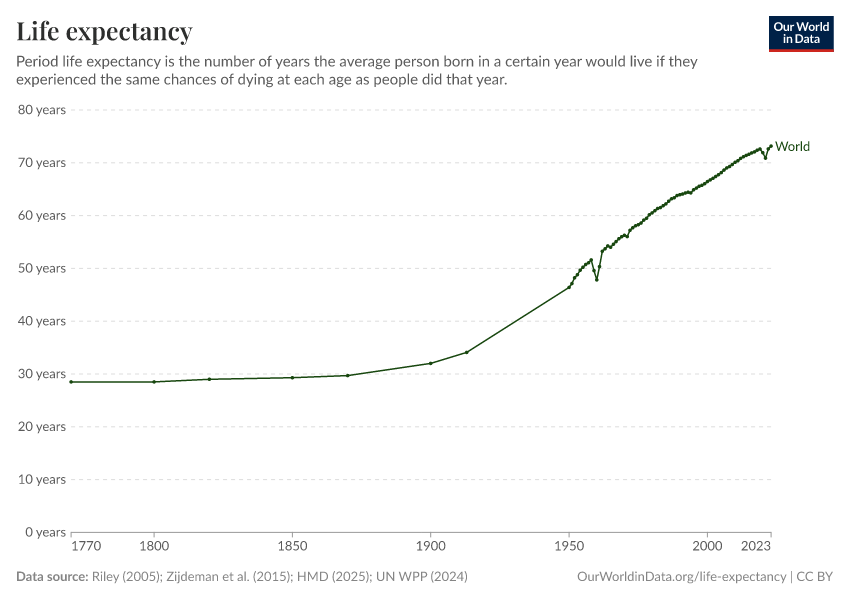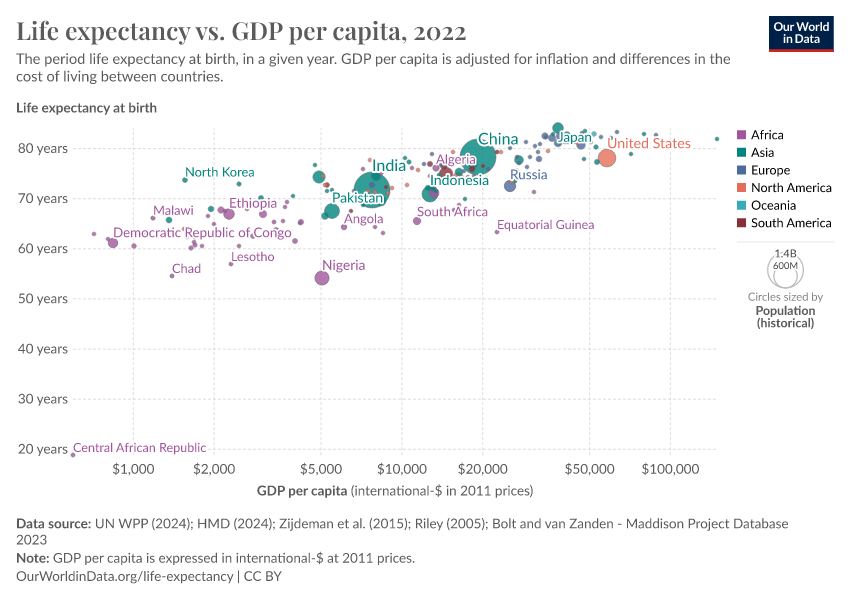Life expectancy

What you should know about this indicator
- Across the world, people are living longer. In 1900, the global average life expectancy was 32 years. By 2023, this had more than doubled to 73 years.
- Countries around the world made big improvements, and life expectancy more than doubled in every region. This wasn’t just due to falling child mortality; people started living longer at all ages.
- Even after World War II, there have been large drops in life expectancy, such as during the Great Leap Forward famine in China, the HIV/AIDS epidemic in sub-Saharan Africa, the Rwandan genocide, or the COVID-19 pandemic.
- Period life expectancy is an indicator that summarizes death rates across all age groups in one particular year. It shows how long the average baby born in that year would be expected to live if they experienced the same chances of dying at each age as people did in that year.
- This chart shows long-run estimates of life expectancy compiled by our team from several data sources. Before 1950, for country-level data, we rely on the Human Mortality Database (2025) combined with Zijdeman (2015). For regional data, we use Riley (2005). From 1950 onward, we use the United Nations World Population Prospects (2024).
- Detailed information on the source of each data point can be found on this page.
Related research and writing
What you should know about this indicator
- Across the world, people are living longer. In 1900, the global average life expectancy was 32 years. By 2023, this had more than doubled to 73 years.
- Countries around the world made big improvements, and life expectancy more than doubled in every region. This wasn’t just due to falling child mortality; people started living longer at all ages.
- Even after World War II, there have been large drops in life expectancy, such as during the Great Leap Forward famine in China, the HIV/AIDS epidemic in sub-Saharan Africa, the Rwandan genocide, or the COVID-19 pandemic.
- Period life expectancy is an indicator that summarizes death rates across all age groups in one particular year. It shows how long the average baby born in that year would be expected to live if they experienced the same chances of dying at each age as people did in that year.
- This chart shows long-run estimates of life expectancy compiled by our team from several data sources. Before 1950, for country-level data, we rely on the Human Mortality Database (2025) combined with Zijdeman (2015). For regional data, we use Riley (2005). From 1950 onward, we use the United Nations World Population Prospects (2024).
- Detailed information on the source of each data point can be found on this page.
Sources and processing
This data is based on the following sources
How we process data at Our World in Data
All data and visualizations on Our World in Data rely on data sourced from one or several original data providers. Preparing this original data involves several processing steps. Depending on the data, this can include standardizing country names and world region definitions, converting units, calculating derived indicators such as per capita measures, as well as adding or adapting metadata such as the name or the description given to an indicator.
At the link below you can find a detailed description of the structure of our data pipeline, including links to all the code used to prepare data across Our World in Data.
Notes on our processing step for this indicator
This chart combines data from several sources. For country-level data before 1950, we use the Human Mortality Database (2025) data and Zijdeman et al. (2015). For country-years where these sources overlap, we use the Human Mortality Database.
For regional data, before 1950, we use Riley's (2005) estimates.
From 1950 onwards, we use the United Nations World Population Prospects (2024) for both country-level and regional data.
Detailed information on the source of each data point can be found on this page.
Reuse this work
- All data produced by third-party providers and made available by Our World in Data are subject to the license terms from the original providers. Our work would not be possible without the data providers we rely on, so we ask you to always cite them appropriately (see below). This is crucial to allow data providers to continue doing their work, enhancing, maintaining and updating valuable data.
- All data, visualizations, and code produced by Our World in Data are completely open access under the Creative Commons BY license. You have the permission to use, distribute, and reproduce these in any medium, provided the source and authors are credited.
Citations
How to cite this page
To cite this page overall, including any descriptions, FAQs or explanations of the data authored by Our World in Data, please use the following citation:
“Data Page: Life expectancy”, part of the following publication: Saloni Dattani, Lucas Rodés-Guirao, Hannah Ritchie, Esteban Ortiz-Ospina, and Max Roser (2023) - “Life Expectancy”. Data adapted from Human Mortality Database, United Nations, Zijdeman et al., James C. Riley. Retrieved from https://archive.ourworldindata.org/20251022-222946/grapher/life-expectancy.html [online resource] (archived on October 22, 2025).How to cite this data
In-line citationIf you have limited space (e.g. in data visualizations), you can use this abbreviated in-line citation:
Riley (2005); Zijdeman et al. (2015); HMD (2025); UN WPP (2024) – with major processing by Our World in DataFull citation
Riley (2005); Zijdeman et al. (2015); HMD (2025); UN WPP (2024) – with major processing by Our World in Data. “Life expectancy – Riley; Zijdeman et al.; HMD; UN WPP – Long-run data” [dataset]. Human Mortality Database, “Human Mortality Database”; United Nations, “World Population Prospects”; Zijdeman et al., “Life Expectancy at birth v2”; James C. Riley, “Estimates of Regional and Global Life Expectancy, 1800-2001” [original data]. Retrieved December 7, 2025 from https://archive.ourworldindata.org/20251022-222946/grapher/life-expectancy.html (archived on October 22, 2025).



